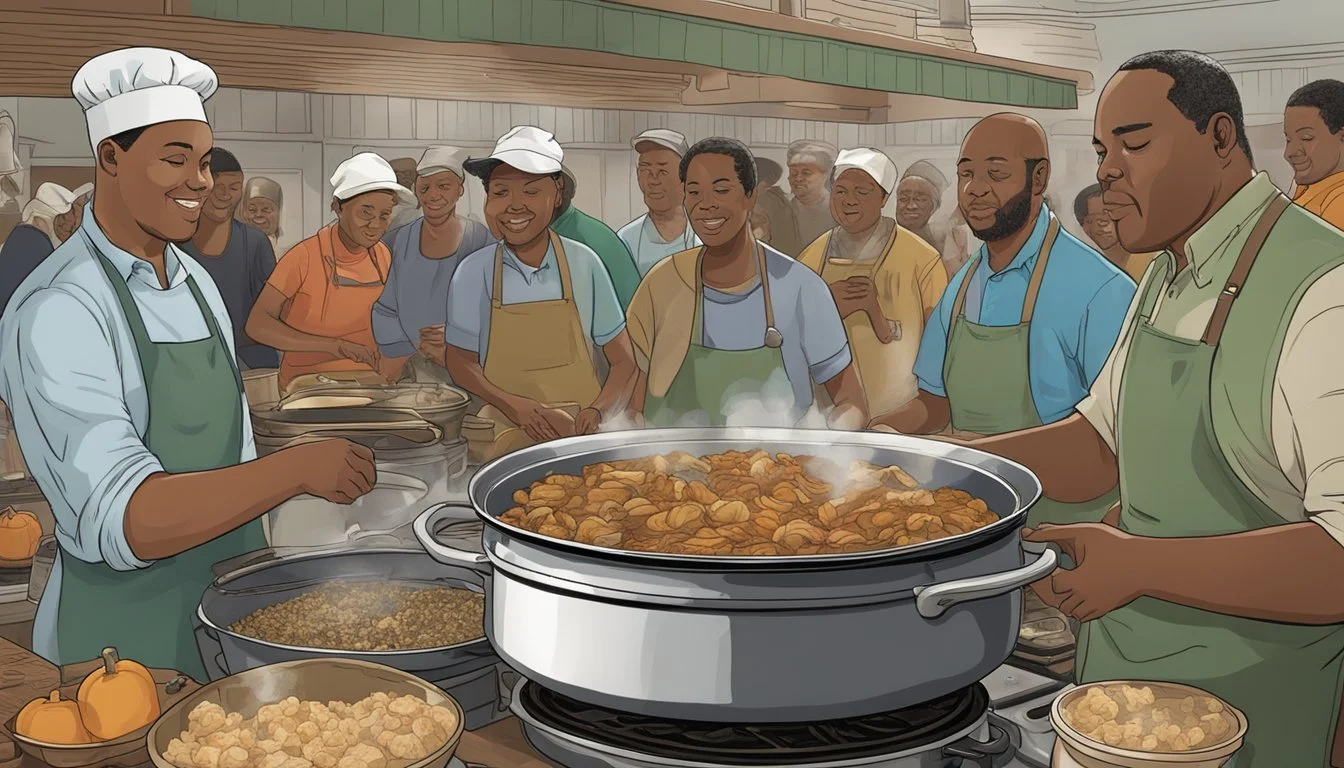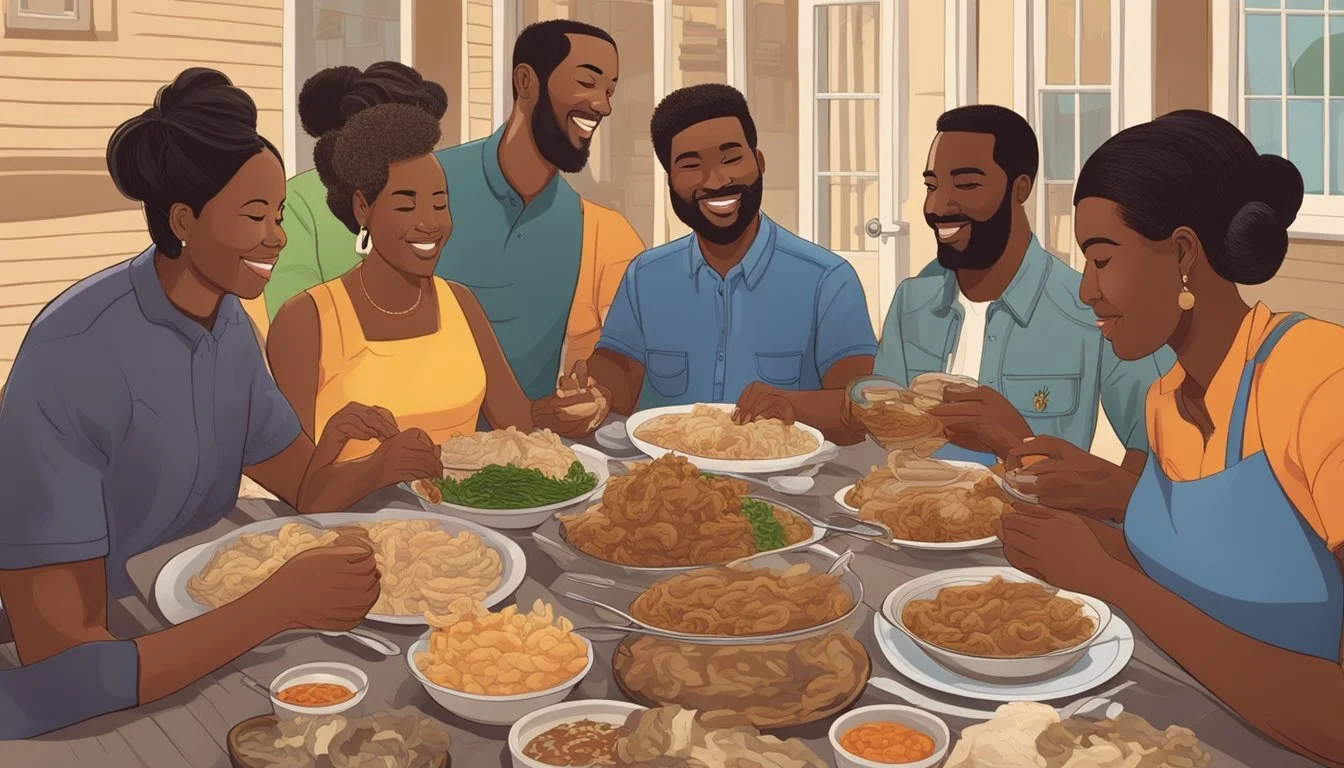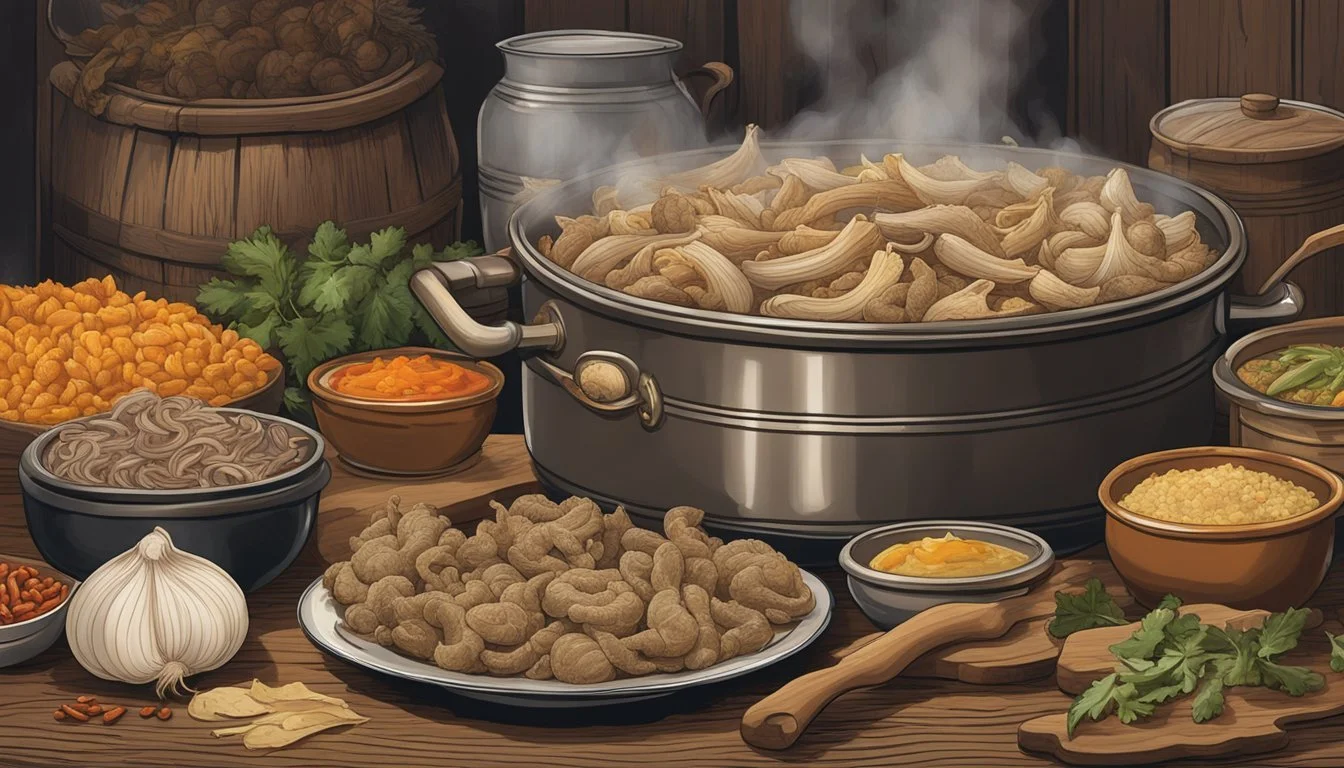Chitterlings
Exploring the Heritage of a Southern Delicacy
Chitterlings, commonly known as chitlins, are a traditional Southern dish with a storied past that traces back to the days of slavery. These are the small intestines of a pig, meticulously cleaned, boiled, and often fried, serving as a testament to the resourcefulness and culinary creativity of African American communities. Over time, chitterlings have evolved into a celebrated soul food delicacy known for their distinctive taste and cultural significance. They are especially popular during the holiday season and have become synonymous with African American heritage and Southern cuisine.
This dish exemplifies the enduring legacy of soul food, a genre of cuisine that encompasses the heart of Southern cooking with its rich flavors and communal spirit. Soul food has roots in the African American experience, reflecting a history of adaptation and innovation under hardship. In the Southern United States, soul food dishes like chitterlings have not only provided sustenance but have also served as a medium for cultural expression and identity.
Within the realm of Southern cuisine, chitterlings hold a unique position as both a subject of culinary tradition and a symbol of cultural resilience. As generations have passed, the preparation of chitterlings has remained a cherished culinary practice, highlighting the importance of family, community, and the preservation of heritage through food. Despite the labor-intensive process and the strong aroma characteristic of their preparation, chitterlings continue to grace dining tables as a beloved dish in Southern soul food cuisine.
Historical Context
Chitterlings, commonly known as chitlins, are more than just a food item; they are deeply woven into the tapestry of Southern history and African American cultural identity, symbolizing both tradition and resilience.
Origins and Cultural Significance
Chitlins trace their roots to West Africa, where they were originally enjoyed by the Yoruba people. The dish's journey to America is closely tied to the transatlantic slave trade, as enslaved Africans brought with them their culinary practices. Over time, chitlins evolved into a symbol of ingenuity and cultural significance, often representing the ability of African Americans to create something valuable from very little.
Chitlins in American History
During the Jim Crow era, African Americans were often left with the less desired parts of the hog, which included the intestines. Despite such limitations, their culinary creativity turned chitlins into a sought-after soul food. Throughout American history, this dish became a testament to the ingenuity and resilience of African American communities, particularly in the Southern states where it remains a staple during special occasions and holidays.
The Chitterlings Circuit
The "Chitlin Circuit" was a string of performance venues throughout the American South where African American entertainers could perform during the era of racial segregation. This network not only provided entertainment but also helped to foster a sense of community and celebration, often with chitlins being served to patrons. The term has since become emblematic of African American perseverance in the face of adversity and has left a lasting impact on American culture.
Culinary Details
Exploring chitterlings, or 'chitlins', requires an understanding of what they are, traditional ways of preparing them, and how modern cooking has adapted these practices.
What Are Chitterlings?
Chitterlings are the cleaned and cooked small intestines of pigs, a dish with a deep-rooted heritage in Southern soul food. They are known for their distinctive flavor and texture, which can be quite tender when cooked properly. Safety is paramount when handling chitlins, as thorough cleaning is necessary to prevent bacterial contamination.
Traditional Preparations
Ingredients and Cooking Method
Traditionally, chitlins are prepared by boiling. This method entails:
A thorough cleaning process to ensure safety.
Ingredients: A blend of aromatic seasonings such as chopped onion, garlic, and pepper for flavor, with salt and sometimes vinegar for a subtle tang.
Cooking: The pig intestines are then boiled for several hours until tender, allowing for the seasonings to permeate through the meat.
Resulting Flavor and Texture
The flavor becomes concentrated and more flavorful as the chitlins cook.
A soft, yet chewy texture is typical for properly cooked chitlins.
Modern Cooking Variations
Modern recipes often introduce variations in cooking methods and additional flavors.
Alternative Methods
Frying: Some chefs choose to fry chitlins after boiling to add a crispy texture.
Safety: Regardless of the innovations in cooking methods, the priority on safety and cleanliness remains constant.
Flavor Enhancements
New seasonings and marinades have been incorporated, creating a wider spectrum of tastes while maintaining the soul food tradition.
Bold Spices: The inclusion of spices such as cayenne or paprika can add a kick to the dish.
Variations on the traditional vinegar and hot sauces can also be used to enhance the flavor profile.
Recipes and Pairings
Chitterlings, often referred to as chitlins, are a traditional southern soul food staple with a distinct preparation process and flavor profile. Culinary enthusiasts and home cooks alike delve into making this dish, pairing it with sides that enhance their savory character.
Classic Chitterlings Recipe
The classic chitterlings recipe involves thorough cleaning and boiling of the chitterlings until tender, which typically takes around three hours. While variations are plentiful, a fundamental aspect involves incorporating aromatic vegetables such as onions (What wine goes well with onions?) and green bell pepper, along with seasoning agents like salt, black pepper, and sometimes a dash of hot sauce or apple cider vinegar for added tang.
Ingredients:
5 lbs chitterlings
1 large onion, chopped
1 green bell pepper, chopped
2 tablespoons apple cider vinegar
4 cups of water
Salt and pepper to taste
Optional: hot sauce to taste
Instructions:
Clean the chitterlings thoroughly, removing debris and excess fat.
Cut the cleaned chitterlings into smaller pieces.
In a large pot, add chitterlings, onion, green bell pepper, and water.
Season with salt, pepper, and apple cider vinegar.
Bring to a boil, then reduce heat to medium and cover.
Simmer for about 3 hours or until chitterlings are tender.
Occasional stirring is recommended to ensure even cooking.
Accompaniments and Sides
Chitterlings are commonly served with dishes that complement their rich flavor. Collard greens and cornbread are traditional accompaniments, where the greens bring a slight bitterness that pairs nicely with the chitterlings, while the cornbread offers a sweet, crumbly contrast to the dish's textural composition.
Top Accompaniments:
Collard greens: usually simmered with bacon or ham hocks for a smoky taste.
Cornbread: can be classic and savory or slightly sweetened, baked to a golden crust.
Potato salad: a creamy and cold contrast to the warm chitterlings.
Black-eyed peas: for a hearty and nutritious side.
Adding hot sauce to chitterlings is also a common practice for those who prefer an extra kick, making it a versatile dish that pairs wonderfully with a variety of flavors present in soul food cuisine.
Health and Safety Considerations
When dealing with chitterlings, one must approach the health and safety considerations with due diligence to avoid the risk of foodborne illnesses such as E. coli, Salmonella, and Yersiniosis. Proper cleaning and thorough cooking are critical to prevent contamination from harmful bacteria typically present in feces.
Cleaning and Preparation
Chitterlings must be meticulously cleaned before cooking. Safety begins with the following steps:
Rinse chitterlings thoroughly in cold water to remove any lingering debris.
Soak them in a mixture of cold water and baking soda for a few minutes to help with cleaning.
Clean each piece one by one, trimming away excess fat and any foreign matter.
Sanitize the work area, cutting boards, and utensils used in the cleaning process to prevent cross-contamination.
Cooking Safety Tips
Cooking chitterlings properly is essential to ensure that all harmful bacteria are eliminated:
Boil chitterlings upon initial cleaning for at least 5 minutes to reduce bacteria.
Simmer the chitterlings over medium heat for about 3 hours or until tender to ensure they are cooked sufficiently and achieve a safe internal temperature.
Keep the cooking area clean and avoid contact with other foods to prevent cross-contamination.
Always wash hands thoroughly after handling raw chitterlings to avoid spreading bacteria such as E. coli and Yersiniosis.
Cultural and Social Impact
Chitterlings have left an indelible imprint on Southern and African American culinary landscapes. This staple not only symbolizes ingenuity and resilience through cuisine but also reflects the evolution of cultural significance across holiday tables and everyday meals.
Symbol of Resilience
Chitterlings, colloquially known as "chitlins," are a testament to the resilience of African Americans. Historically, these dishes emerged during the era of slavery, where slaves were given the least desirable parts of the hog. Over time, African Americans transformed chitlins into a comfort food that bears significance far beyond its ingredients. These dishes have endured through centuries and now grace the tables during festive seasons like Thanksgiving and Christmas, illustrating a journey from meager beginnings to celebratory feasts.
Influence on Southern and African American Food
Chitterlings have significantly influenced both Southern cooking and African American food traditions. Integral to soul food, a genre that celebrates African American culinary heritage, chitlins epitomize the creativity and ingenuity need to turn simple ingredients into rich, flavorful experiences. Their unique taste and texture contribute to the diverse palate of Southern cuisine, making them a beloved dish. As part of culinary tradition, chitlins have evolved from a historical food staple to a central element in modern renditions of comfort and holiday dishes, securing their cultural significance for generations to come.
Global Perspective
Chitterlings, a dish deeply rooted in Southern American cuisine, has connections and counterparts that extend globally, reflecting a widespread use of similar ingredients and practices.
Chitterlings Worldwide
In various parts of the world, chitterlings have distinct analogs that resonate with local culinary traditions. In Europe, a dish akin to chitterlings can be found in the form of haggis, a Scottish delicacy comprising sheep's offal mixed with oatmeal and seasoning, encased in the animal's stomach. Moving to Asia, different cultures embrace offal as well, often seen in specialty dishes that are sold in numerous Asian markets. Variations of intestines are regularly consumed, either stewed or grilled, in countries such as Korea, China, and Japan, where dishes like motsu in Japan showcase a similar utilization of the ingredient.
In Latin America, chitterlings take a form known as chinchulín, common in cuisines across the region, from Argentina to Mexico. These are often grilled and seasoned to create a distinctive flavor profile. The presence of chitterlings and their regional varieties in Latin or Asian markets in the United States exemplifies their global reach and the cultural crossover in culinary practices.
Comparative Delicacies
The global culinary scene offers a rich palette of organ meats prepared in various ways, each with its unique heritage and flavor. Tripe, the stomach lining of a cow, is widely consumed across the world and is a key ingredient in many traditional soups and stews, from menudo in Mexico to pho in Vietnam. In France, andouille is a type of sausage made with chitterlings, providing a different form and taste from its American namesake, which uses mostly pork muscle. These delicacies, though diverse in preparation, highlight a shared thread of resourcefulness in cooking. The use of all parts of the animal is a commonality across many cultures, demonstrating a universal respect for the food source and an appreciation for the variety of textures and tastes offal offers.
Contemporary Conversations
The dialogue surrounding chitterlings has evolved, touching upon their cultural relevance in modern cuisine and the surrounding economic and ethical discussions.
Chitterlings in Modern Cuisine
Chitterlings remain a cherished dish within Southern and soul food traditions, often featured in family gatherings and festive occasions. Renowned platforms such as Grandbaby Cakes have contributed to their continued popularity by sharing traditional recipes that encourage exploring these flavors. Critics and enthusiasts alike recognize chitterlings as a delicacy, particularly within culinary circles that value 'waste not, want not' principles and the full utilization of an animal—offal included.
Economic and Ethical Considerations
The production and consumption of chitterlings encapsulate broader economic and ethical concerns. Economic Aspects involve the affordability of offal compared to more mainstream cuts of meat, which sometimes makes chitterlings a budget-friendly option within communities. However, this must be balanced against the Ethical Considerations that arise from animal welfare concerns and the environmental impact of meat production. The dialogue continues as consumers and producers alike navigate these complex issues, striving to honor culinary heritage while responding to contemporary ethical standards.







